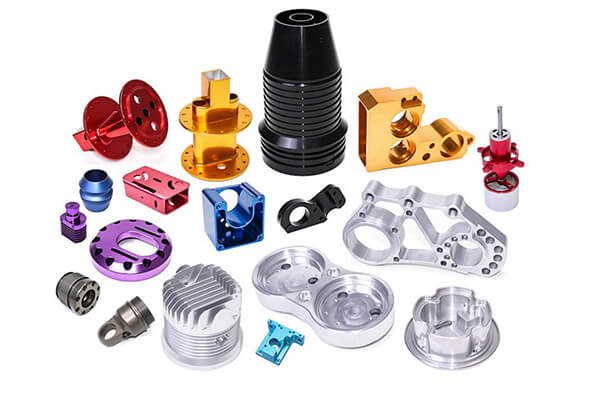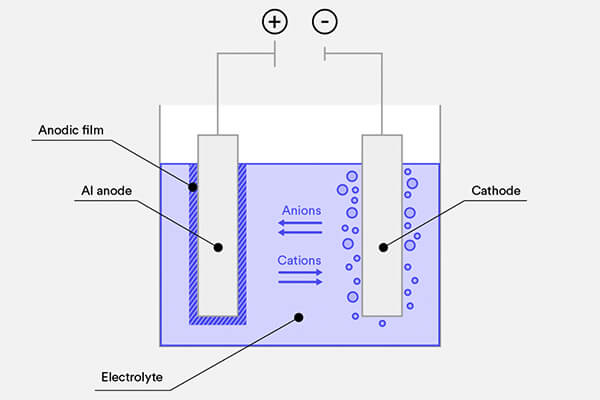Anodized Aluminum: Finishing Process For Aluminum Parts
Anodized Aluminum is a practical method of surface finishes. The surface properties of metals, particularly aluminum, can be improved through the electrochemical process of anodizing. It entails the controlled oxidation of the metal, generally aluminum, to produce an oxide layer that serves as protection. Compared to the oxide coating that naturally forms on other metals, this layer of anodized aluminum is often thicker, tougher, and more corrosion-resistant. The thickness and properties of the anodized aluminum layer can also be tailored to suit specific applications.
Sungplastic company is good at anodized aluminum and other surface treatments of plastics or metals. If you are looking for surface finishes services about aluminum parts or products, we can provide good advice and processing solutions.

How is Aluminum Anodized?
The process of aluminum anodization begins with a thorough cleaning and rinsing of the aluminum surface. Subsequently, the aluminum is immersed in an electrolytic solution, such as sulfuric acid. This solution is an electrically conductive medium containing abundant positive and negative ions eager to exchange charges.
During anodization, a positive electric charge is applied to the aluminum, designating it as the “anode.” Simultaneously, negative charges are directed toward plates suspended within the electrolyte. The flow of electric current in this circuit prompts positive ions to migrate towards the negative plates, while negative ions converge on the positive anode, which is the aluminum piece itself.

What is a Barrier Layer in Anodizing?
The electrochemical reactions occurring during anodization lead to the formation of pores on the aluminum surface, as excess positive ions escape. These pores exhibit a regular geometric pattern and gradually penetrate into the substrate. At the surface, aluminum combines with negatively charged oxygen ions to generate aluminum oxide. This protective layer is termed the “barrier layer,” and it serves as a shield against further chemical reactions at those specific locations.
As the application of current persists, the relatively vulnerable and reactive areas within the pores continue to penetrate deeper into the substrate, creating a series of hollow, column-like structures.
The more prolonged the current application, the deeper these columns extend. For standard non-hard coatings, their depth can reach up to 10 microns. Once this threshold is attained, and if coloration is unnecessary, the process is halted, and the surface can be sealed by rinsing it with water. This results in a robust, naturally occurring aluminum oxide coating capable of withstanding chemical attacks and exhibiting impressive scratch resistance. Aluminum oxide ranks 9 out of 10 on the Mohs hardness scale, second only to diamond.
What is Hard Anodizing?
Hard anodizing, often referred to as Type III anodizing, offers enhanced corrosion protection and resistance to wear, making it suitable for extreme environments or components exposed to significant friction. Achieving this involves prolonging the application of electrical current until the pore depth exceeds 10 microns, extending all the way to 25 microns or more. This process demands more time and resources but yields a superior final product.
Does Aluminum Require Corrosion Protection?
While aluminum doesn’t rust, it can deteriorate due to oxidation when exposed to oxygen. Oxidation, simply put, involves reacting with oxygen. Oxygen readily forms compounds with most other elements. When aluminum is exposed to the atmosphere, it rapidly forms a layer of aluminum oxide on the surface, providing a degree of protection against further corrosion.
However, aluminum must contend with more than just pure air and water. Environmental factors such as acid rain, saltwater, and contaminants can exploit vulnerabilities in the surface passivation. Even modern alloys can exhibit various responses to such environmental exposure, ranging from surface discoloration to mechanical failure.
How is Color Incorporated in Metal Anodizing?
When we envision anodizing, colored aluminum often comes to mind. This is where the brilliance of the process truly shines. The structured pores etched into the surface serve as ideal receptacles for introducing tints or pigments.
Pigments fill these empty pores up to the surface, where they are permanently sealed. Consequently, anodized colors are exceptionally durable, resistant to surface scratching because the colors are embedded deep within the material and can only be removed by grinding away the underlying substrate.
Why Does Anodized Aluminum Exhibit a Distinct Metallic Sheen?
Following coloration, anodized aluminum acquires its characteristic “metallic” appearance. Two factors contribute to this phenomenon. First, the uniform electrochemical etching leaves a rough surface behind. The greater the pore depth, the rougher the surface, but correspondingly, the colors become more enduring.
Secondly, when light strikes the surface, it interacts partially with the colorant and partially with the uncolored metal at the surface. Consequently, the light that reflects back to the observer is a combination of two distinct wavelengths interacting as they reflect from slightly different surfaces, resulting in the distinctive shine associated with aluminum anodization.
Can Materials Other Than Aluminum Undergo Anodization?
Yes, anodization is compatible with materials beyond aluminum, including magnesium, titanium, and even conductive plastics. It is an economical, reliable, and exceptionally durable process. This versatility makes it a popular choice for architectural fittings due to its aesthetic appeal and resilience against weathering.
Why Can’t an Entire Part Be Anodized?
Anodization necessitates the immersion of a part in a sequence of chemical baths. To keep a part in place during this process, it must be affixed to a hanger or support, preventing it from sinking to the tank’s bottom. Wherever the holding fixture contacts the part, that area remains inaccessible to the anodizing chemicals, resulting in improper anodization. Therefore, it is prudent to design a location on the part that can serve as a holding point without causing cosmetic issues.
Benefits of Anodized Aluminum Finishes
Anodized aluminum coatings offer a myriad of advantages that make them a preferred choice in various industries. There are some notable advantages to consider.
- Corrosion Resistance
Anodized aluminum’s foremost benefit is its exceptional resistance to corrosion. The formation of a protective layer of aluminum oxide on the surface acts as a barrier, shielding the metal from environmental elements, moisture, and chemicals. - Enhanced Durability
Anodized aluminum surfaces are significantly tougher and more abrasion-resistant than untreated aluminum. This makes them well-suited for applications exposed to wear and tear, ensuring a longer lifespan for products. - Color Customization
Anodized aluminum provides an extensive palette of color options through dyeing techniques. This flexibility allows for customized finishes, making it an attractive choice for architectural design and consumer products. - Low Maintenance
Anodized aluminum requires minimal maintenance to retain its appearance and functionality. It resists staining, doesn’t chip or peel, and can easily be cleaned with mild detergents and water. - UV Stability
Anodized finishes are UV-resistant, making them ideal for outdoor applications. They won’t fade or degrade when exposed to sunlight, ensuring long-lasting aesthetics. - Electrical Insulation
Anodized aluminum coatings provide electrical insulation, which is valuable in electronics and electrical applications where conductivity needs to be controlled. - Non-Toxic and Safe
Anodizing is an environmentally friendly process that produces no harmful byproducts. The resulting surface is non-toxic and safe for contact with food and skin. - Recyclability
Anodized aluminum is fully recyclable. It can be easily reclaimed and reused without compromising its quality, contributing to sustainability efforts. - Fire Resistance
Anodized aluminum is inherently fire-resistant, making it a suitable choice for building exteriors, aircraft components, and other fire-sensitive environments. - Improved Adhesion
Anodized surfaces provide a better substrate for adhesion, enhancing the bonding of paints, adhesives, and other coatings. - Cost-Effective
Despite its many benefits, anodized aluminum remains cost-effective, offering a high return on investment due to its longevity and low maintenance requirements. - Wide Range of Applications
Anodized aluminum finds applications in diverse industries, including architecture, automotive, aerospace, consumer goods, and more, owing to its versatility and adaptability. - Texture Options
Alongside color, anodized aluminum can also feature various textures, providing design flexibility for achieving specific aesthetics and tactile qualities. - Chemical Resistance
Anodized surfaces are resistant to many chemicals, making them suitable for industrial and laboratory environments where exposure to corrosive substances is common. - Improved Heat Dissipation
In electronic devices, anodized aluminum can aid in heat dissipation, enhancing the performance and longevity of components.
Anodized Aluminum Applications Across Industries
Anodized aluminum finds a multitude of applications across diverse industries, thanks to its unique combination of properties. Here’s a glimpse into how anodized aluminum serves various sectors.
-
- Aerospace
In the aerospace industry, anodized aluminum components are prized for their lightweight, corrosion-resistant properties. They are used in aircraft structures, landing gear, and interior fittings. - Automotive
Anodized aluminum plays a critical role in the automotive sector, where it enhances the durability of various parts such as wheels, trim, and engine components while providing a sleek, decorative finish. - Architectural
Architectural firms and builders utilize anodized aluminum for facades, windows, doors, and other structural elements. Its corrosion resistance and aesthetic appeal make it a favored choice. - Electronics
The electronics industry employs anodized aluminum for housings, heat sinks, and enclosures. It offers thermal conductivity and electrical insulation, ensuring the safety and functionality of electronic devices. - Medical
Anodized aluminum is used in medical equipment and devices due to its biocompatibility, ease of sterilization, and resistance to corrosion, making it ideal for surgical instruments and diagnostic devices. - Marine
Anodized aluminum thrives in marine environments due to its resistance to saltwater corrosion. It’s found in boat fittings, rigging, and other marine equipment. - Sporting Goods
Manufacturers of sporting goods like bicycles, fishing equipment, and firearms appreciate anodized aluminum for its lightweight, durable, and weather-resistant qualities. - Military
Anodized aluminum’s durability and protective coating make it invaluable in military applications, including weaponry, vehicle components, and aircraft. - Consumer Goods
Everyday products like cookware, cameras, and mobile devices benefit from anodized aluminum’s scratch-resistant, decorative finishes. - Construction
In the construction industry, anodized aluminum is used in curtain walls, railings, and roofing due to its resistance to weathering and low maintenance requirements. - Electrical
Electrical components and enclosures often employ anodized aluminum for its insulation and protective properties. - Industrial Equipment
Anodized aluminum is chosen for machinery and industrial equipment due to its ability to withstand harsh environmental conditions and resist chemical exposure. - Renewable Energy
In the renewable energy sector, anodized aluminum is found in solar panel frames, wind turbine components, and other renewable energy infrastructure due to its corrosion resistance and lightweight nature. - Food Processing
Anodized aluminum is used in food processing equipment and packaging due to its non-reactive, easy-to-clean surface. - Art and Design
Artists and designers incorporate anodized aluminum into sculptures, furniture, and decorative elements for its versatility and aesthetic appeal. - Transportation
In addition to aerospace and automotive, anodized aluminum is used in railways, ships, and public transportation for its lightweight and corrosion-resistant qualities.
- Aerospace
Anodized aluminum’s versatility, corrosion resistance, and aesthetic appeal make it an essential material in a wide range of industries, contributing to the durability and performance of countless products and components.
Is anodizing suitable for your needs of aluminum parts? Whether rapid prototypes or low to high volume manufacturing, we provide surface finishing services for metals.
Contact us for our quality services. Just for you!
Get a free quote and design analysis today.
We’ll reply to you within 6 working hours.
We respect your privacy.
+86 139 2927 4777 (WhatsApp, Wechat)

